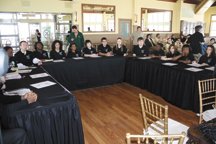Students from the Bayonne schools teamed up with students from East Orange for an Environmental Summit at the Liberty House in Jersey City last month in an effort to get a better understanding of the changes in environment and humanity’s impact on it.
Called the 1010 Student Exchange of Ideas on Sustainable Energy and the Environment, the summit was the culmination of several months of study that included interaction between the two school districts.
The all-day event included outdoor cleanup activities near Liberty State Park, part of an effort to give hands-on experience to students in dealing with the environment.
“These shores were teaming with fish and oysters.” — David Minard
________
The day included a press conference and several roundtable discussions.
Hosted by the NJ Clean Communities Council, the cities of Bayonne and East Orange, the Hudson County Improvement Authority, and PSE&G, the summit was designed to facilitate an exchange of information and ideas on environmental issues related to litter and the proper handling of waste among groups of students from points all over New Jersey, with special attention to water conservation.
“The Clean Communities Student Environmental Exchange is a great opportunity to stress to young environmental stewards that there is no road map for environmental action, but if you listen to nature, nature will let you know what you need to do,” said Richard Dwyer, public affairs manager for PSE&G. “If you don’t hear birds singing or leaves blowing in the breeze in your urban neighborhood, find a way to help plant trees. If you see an empty can tumbling down the street, pick it up and dispose of it properly.”
Caleb Price, an eighth grade student at Woodrow Wilson, asked during the summit, “When will people begin to adapt to nature rather than forcing animals, birds, trees, waterways and air to adapt to human beings?”
He said he had learned about the harmful effects of pollution and how oysters helped clean the water.
Perhaps his lessons at the summit spell hope for the future, since Price said he would like to enter politics.
David Minard, director of the science department, said one area that the Bayonne schools were interested in involved developing oyster beds, not only the science – which shows that oysters play a huge role in cleaning up polluted waters – but also in history. Bayonne and New York Harbor were at one time huge producers of oysters.
“These shores were teaming with fish and oysters,” he said. “We find that this makes alike with the past, and helps lead to an appreciation of science.”
Brady Cashman, an eighth grader at Woodrow Wilson School, said he learned a lot of things he didn’t know about the watershed, and hadn’t done much about cleaning it up before they went out to pick up trash along the waterfront.
“There was a lot of trash,” he said.
Nicholas Petriello, also an eighth grader from Woodrow Wilson, was particularly pleased by the oyster project, saying that he had learned a lot. While he said he wasn’t likely to get a job in the environmental field in the future, he would be donating to environmental causes.
Danielle Jimenez, a senior at Bayonne High School, said she became interested in the environmental issues when she was still in elementary school, but got involved in the summit as a result of taking a marine biology course at the high school. She said people can make a difference in whether or not the environment is maintained.
Arthur Kosakowksi, a senior, took the same course and was impressed by the oyster project, and that he liked playing a role in helping to clean up the environment.
Madeline Smith, a senior, said that before she got involved with the program, she didn’t know much about oysters, and she intends to continue her studies in the environment.
Marcine Chojnowki, another senior, also said she wanted to help the environment.
While some of the students said they would follow a career path in the environment, while others were looking into fields such as engineering or education, all said the environment would play a role in their lives in the future.
New Jersey was among the nation’s leading sources of oysters until a 1957 blight destroyed many of the beds. In 1997, local officials sought to change this and began an experiment with the New York/New Jersey Baykeepers to begin developing beds in various local waterways.
“The Hudson Reporter played a big part in letting people know what we were doing,” Dwyer said.
Last year, Tokar and Drennan coordinated a student-run citywide effort in Bayonne that raised about 12,000 oysters in the city. PSE&G helped construct and donated many of the floats needed to make this possible
“Oysters are little bio-engineers,” Dwyer said. “What they do is take the silt and pollution out of the water. In their digestive process, they make little packets and dispose them on the bottom. The crabs come along and east the packets. So all the stuff that is free-floating in the water gets processed. Each oyster can process up to 50 gallons a day.”
